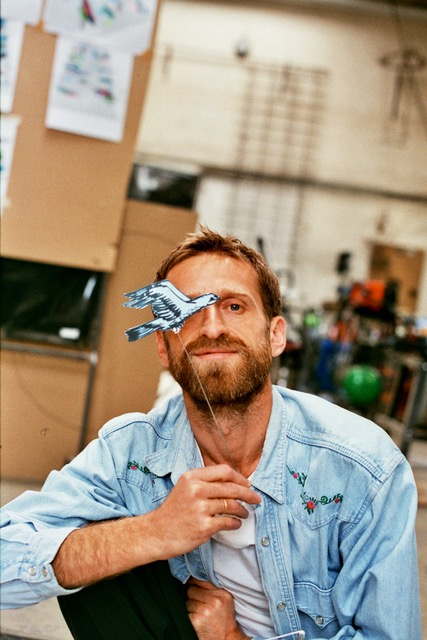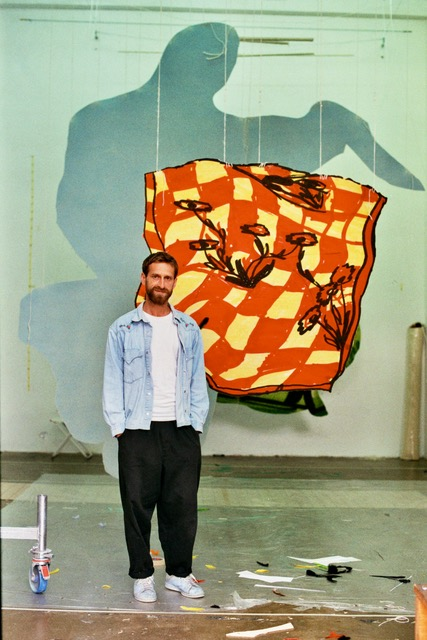The boy whose fantastical visions of the Kosovo War captured the world
In a clip broadcast by a Swedish Television news programme on 17 May 1999, 13-year-old Petrit Halilaj gave his first matter-of-fact account of how Serbian police and special forces killed 152 people in a Kosovan village not far from his hometown. Now known as the massacre of Izbika, the event was one of the most horrific mass executions of the Serbia-Kosovo war.
Watching the footage now, it’s difficult to see the young Halilaj as just a kid: he is poised and remarkably pragmatic in his word choice, aware that he’s speaking on behalf of Kosovars who have lost relatives and homes. It’s only when the topic changes to drawing — particularly his love of sketching parrots — that he beams with childlike wonder. “I drew these because I’m so into them,” he says, grinning quietly.
Now 35-years-old and opening his first solo UK show — Very volcanic over this green feather — at Tate’s westernmost outpost in St Ives, Cornwall, Halilaj wears the same expression of unbridled glee. He shows the natural world he has recreated in two-dimensional pieces of felt: peacocks and palm trees taken from his childhood drawings are delicately suspended from the gallery ceiling. As you navigate the installation, you encounter a pair of antelopes grazing, hens wandering. Then, amid some shrubbery, you spot a crying boy in the distance — the first sign that this peaceful landscape might be a mirage. From the back of the room, the landscape changes, revealing scenes of massacre depicted in childlike simplicity and frankness, with burning houses, displaced masses, and soldiers wielding guns.
Growing up in the village of Runik during the Serbia-Kosovo war, Halilaj learned to run at the sound of shelling. One day, his father disappeared. Women, children, and the elderly were rounded up. Fearing that the village would be torched, his mother collected a few treasured possessions and buried them in the ground — Halilaj’s drawings were among them. Their home was razed, and his family were forced to flee to Albania, where they found shelter at the Kukës II refugee camp. At the time, they did not know if Halilaj’s father or classmates had been imprisoned or killed.
Like many kids at the camp, Halilaj missed his classes. Without art supplies, he couldn’t continue his creative pursuits. That was until Italian psychologist Giacomo “Angelo” Poli arrived with paper and colourful felt-tip markers. Drawing was to provide distraction and relief from cramped and uncomfortable living conditions — and help the children unload the heavy burdens of war.
Petrit Halilaj, Installation view of Very volcanic over this green feather at Tate St Ives, 2021. Photo: Matt Greenwood, Tate Photography
The pain that emerged from the exercise was harrowing: violence and NATO airstrikes are depicted in utter clarity; Serbian forces and armed KLA (Kosovo Liberation Army or the Ushtria Çlirimtare e Kosovës) fighters fill every page. These sinister scrawlings of the cruelty and chaos of war make Halilaj’s vividly-hued parrots all the more impactful.
“This was the first time anyone had given any attention to me or the other kids,” the artist recalls of his time at the camp with Poli, speaking over Zoom from his Berlin studio. “[The drawings] seemed so important to people. This was when I realised that art can talk to people and that it was important to show what was happening [amidst the war].”
Petrit Halilaj, Paesaggio Fantastico (Fantasy Landscape), 1999. Courtesy the artist and Giacomo Poli
Among the scenes of tragedy, he also found space to dream: populating his drawings with magnificent peacocks, swans floating in serene lakes, and bucolic and tropical landscapes. It’s no coincidence, perhaps, that peacocks unfurl their brilliantly-coloured tail feathers as a defence mechanism — to look larger and more intimidating. In the 13-year-old’s case, drawing these creatures was a way of reconnecting with himself in the turmoil of war. “I was using that time [with Poli] to draw what I love: nature.” It is something the artist is still fascinated by, so much so that when the internet connection drops and he has to switch rooms, Halilaj takes the laptop for a quick tour around his garden, to show me his birdhouses and flowers.
Naturally, the media covering the refugee camp caught sight of Halilaj’s talent and for a moment, war reportage was brightened by his and other children’s artworks. When the UN secretary general Kofi Annan asked to meet the young man, Halilaj’s mum encouraged her son to draw a bigger picture for the occasion. Together, they made a canvas out of the cardboard floor of their tent — still damp from soil on the day of the meeting.
Petrit Halilaj, Installation view of Very volcanic over this green feather at Tate St Ives, 2021. Photo: Matt Greenwood, Tate Photography
In the summer of 1999, Halilaj and his family returned to Runik and reunited with his father. Together, they installed a temporary tent in the rubble of their house. It took many more years to rebuild their home and make it habitable. Meanwhile, Poli believed that the children’s art represented an underappreciated perspective on humanitarian catastrophe and, on his return to Italy, he gathered the drawings to put on an exhibition.
He remained a pivotal supporter of Halilaj’s artistic career: helping the young man secure a scholarship to attend the only art-focused high school in Peja, Kosovo, and later hosting him during his university studies in Milan, Italy. “Without his help, I would never have been able to achieve what I have.” Once Halilaj arrived in Italy, he was finally able to spread his wings. “I wanted to see new things. I felt immensely lucky to have a new life. I had only ever imagined Venice and Paris, then, suddenly, I couldn’t stop travelling,” he beams.
Petrit Halilaj and Dr Giacomo Poli 1999 Courtesy Giacomo Poli
Throughout his career, he never ceased drawing birds, fascinated by their ability to transcend human boundaries. Early on, he exhibited a series of drawings showing an elegant breed of hens, which later inspired his installation: “They are Lucky to be Bourgeois Hens.” He delved into the bird archive of the former Natural History Museum of Kosovo and, in 2020, turned Madrid’s Crystal Palace into a giant bird nest with feeding areas to invite feathered visitors into the building. Though Halilaj hasn’t brought real birds into Tate St Ives, he has sewn bird feathers into his felt wildlife, a representation of the way real life is torn apart and stitched together to form memories.
“I had no interest in going back into the war,” Halilaj reflects. He didn’t consider using his childhood drawings until the pandemic struck. In a smaller, separate room from the St Ives installation, his family’s experience at Kukës II is presented in a display table outlining the conflict of 1998-9, NATO’s interventions, and The Hague International Court of Justice’s ongoing investigations into the war atrocities committed. Despite the timeline starting with in 1998, Halilaj says the tremors were felt long before the start of the war.
Petrit Halilaj, Installation view of Very volcanic over this green feather at Tate St Ives, 2021. Photo: Matt Greenwood, Tate Photography
“The nightmares began at the end of the 80s. My dad had work and we had a sense of regularity in the house. He would even bring toys every other week. Then, he was kicked out of his job, which happened to most Kosovar Albanians. The 90s grew darker and darker. There were no renovations at school. Teachers were unpaid. Albanians and Serbians were divided.” With segregation came the slow enforced assimilation of Kosovar Albanians. “The war started when they closed schools, when they closed theatres, when they cut off culture. That’s the real horror. That’s how politics really sets in.” The policing of culture crept into personal conversations and domestic spaces too. “I loved Serbian music. But my parents discouraged me from listening to it, worried about playing or celebrating our neighbours’ culture.”
Petrit Halilaj, Installation view of Very volcanic over this green feather at Tate St Ives, 2021. Photo: Matt Greenwood, Tate Photography
Whether exhibiting Albanian alphabet books (for his series Abetare), or using performance to bring to life the ruins of his hometown’s House of Culture (for his series Shkrepëtima), his recent projects have been prompted by a desire to revisit, if not rebuild, this lost heritage. The artist knows too well how identity can be erased: he pulled out of the Belgrade Biennial last October, after organisers omitted his nationality from the official list of participants published online (you can read his open letter here). Responding to the Biennial theme of “Dreamers”, Halilaj had wanted to dedicate his work to the dreams of Runik’s citizens, inspired by his former teacher, who he had recently discovered was an actor and activist prior to the war.
“After the withdrawal from the Belgrade Biennial, I went back to the childhood drawings [I made with Poli]. He proposed to curator Anne Barlow that they aren’t treated as kids drawings, but instead ask questions about how to engage with this material. Still, there is something powerful about reclaiming the wonder of childhood imagination. “How else do you unblock something that is already historicised and analysed?”
Studio Petrit Halilaj, work in progress for Tate St Ives exhibition, Spring 2021
You cannot move on from the trauma of war. When you look at the lush landscapes, you cannot unsee those traumatic scenes. But, as the exhibition suggests, you can build a new narrative from those memories.
“We construct the future as we remember the past,” continues Halilaj. “Seeing the latest developments in Europe, the way France and Holland have changed their mind about including southeastern countries into the EU, and the harsh diplomatic war continuing between Kosovo and Serbia, one thing is clear: there’s a lack of vision for a better future.” His disappointment with the Belgrade Biennial inevitably ties into this. “We should be more radical than ever, building new ways to connect. We should have a human point of view rather than a national point of view.”
Petrit Halilaj, Installation view of Very volcanic over this green feather at Tate St Ives, 2021. Photo: Matt Greenwood, Tate Photography
His eyes light up when he talks about the future, a glimmer of optimism that, in the context of Halilaj’s own history and the current pandemic, might seem astounding. That sense of hope is channeled through his felt creatures — reminders that life will flourish from disaster.
He points out an image of a soldier in the exhibition, this time sounding completely celebratory. “With the peacock in the background, it looks a bit like a drag queen dancing.”

